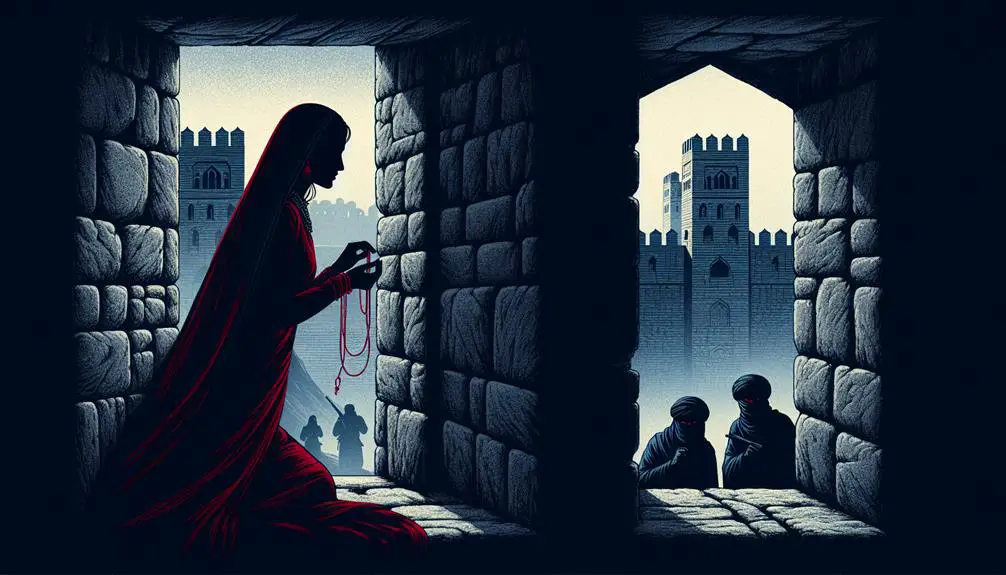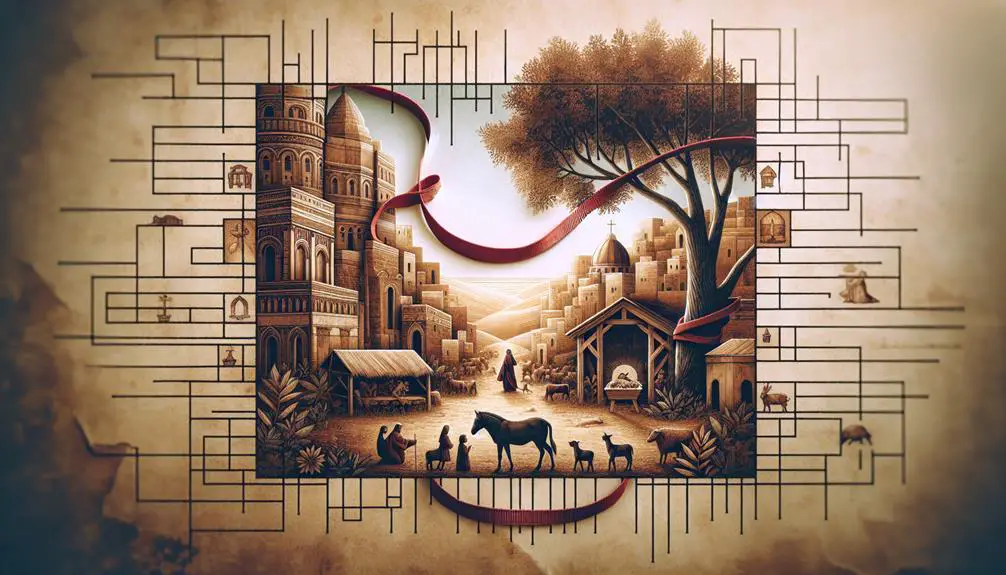Women of the night in biblical narratives reveal complex tales of redemption and grace, inviting a deeper exploration into ancient and modern morals.

Prostitute in the Bible Name
The portrayal of prostitutes in the Bible is a complex subject that intertwines themes of redemption, judgment, and divine mercy. Among these narratives, figures such as Rahab and Mary Magdalene stand out, not merely for their profession but for their pivotal roles in biblical history and theology.
The examination of these characters reveals not only a nuanced understanding of social standings in ancient times but also offers a lens through which to explore the broader messages of forgiveness and transformation within the scriptures. Venturing into these stories invites a deeper consideration of how ancient texts continue to influence contemporary perspectives on morality, identity, and grace.
Key Takeaways
- Rahab and Gomer are explicitly named as prostitutes who played significant roles in biblical narratives.
- The unnamed woman of Jericho and the harlot of Ezekiel's prophecy represent symbolic figures of betrayal and redemption.
- Biblical stories often use prostitute figures to explore themes of faith, transformation, and societal norms.
- Misconceptions, like those around Mary Magdalene, highlight the importance of distinguishing between biblical texts and later interpretations.
Rahab: A Story of Faith

In the tapestry of biblical narratives, Rahab's story emerges as a profound testament to faith and redemption, illustrating the transformative power of belief and the possibility of moral and spiritual reformation. Her narrative, deeply intertwined with the conquest of Jericho, serves as a critical junction between divine promise and human action. Rahab, a prostitute, defied the expectations of her societal role and became an instrumental figure in the Israelite spying tactics, which ultimately led to the fall of Jericho. Her actions, driven by a newfound faith in the God of Israel, signify a pivotal shift from her past life towards a journey of redemption.
The scarlet cord, which Rahab was instructed to tie in her window, symbolizes not only her agreement with the spies but also her faith in God's protection. This element of the story is pivotal, as it represents a covenant of safety amidst impending destruction and a visible sign of her allegiance to Israel's God over her people's idols. The scarlet cord thus becomes a metaphor for Rahab's transformation and salvation, underscoring the biblical theme that faith can lead to redemption regardless of one's past.
Rahab's integration into the Israelite community post-Jericho's fall further amplifies the narrative's message of inclusivity and divine grace. Her story, from a societal outcast to an ancestor of David and Jesus, as outlined in the genealogies of the Bible, exemplifies the boundless scope of redemption. Through her faith and actions, Rahab not only secured her family's safety but also earned a place in the lineage of the Messiah, highlighting the profound impact of faith and the possibility of moral and spiritual renewal.
The Unnamed Woman of Jericho

While Rahab's story is well-documented and celebrated for her faith and transformation, there exists another narrative in the biblical account of Jericho involving an unnamed woman whose tale remains shrouded in mystery and speculation. This shadowy figure, briefly mentioned in the context of Jericho's espionage, symbolizes the untold stories of women who played pivotal roles in the unfolding of biblical history, yet remain unnamed and unrecognized.
The unnamed woman of Jericho, though not explicitly identified or given a voice within the scriptural texts, represents a broader theme of invisibility and anonymity that pervades the narratives of many women in ancient texts. Her existence, inferred rather than detailed, prompts a reconsideration of the roles that unnamed individuals may have played in significant historical and spiritual events.
Aspect |
Significance |
Interpretation |
|---|---|---|
Anonymity |
Highlights the overlooked contributions of women |
Encourages deeper exploration of marginalized narratives |
Context |
Jericho's espionage and the fall of the city |
Reflects the complexity of human experiences in times of conflict |
Rehabilitation narrative |
Absent for the unnamed woman |
Raises questions about inclusivity and redemption in historical narratives |
This table encapsulates the need for a more inclusive approach to historical and scriptural analysis, recognizing the contributions and stories of those who remain unnamed. It challenges readers and scholars alike to ponder the rehabilitation narrative not just for the prominent figures like Rahab but also for the countless unnamed individuals whose stories have been lost to history. In doing so, it beckons a reevaluation of traditional narratives, urging a more comprehensive and inclusive understanding of the past.
Gomer: Love Reclaimed

Gomer's narrative in the Bible, often overshadowed by more prominent figures, represents a profound exploration of redemption and unconditional love within the context of marriage and divine relationship. The story of Gomer, as detailed in the Book of Hosea, serves as a powerful allegory for Israel's relationship with God, emphasizing themes of faithfulness, forgiveness, and the transformative power of love.
- Gomer's Initial Departure: Gomer, the wife of the prophet Hosea, initially leaves her family to pursue a life of infidelity. This act symbolizes the betrayal of Israel, turning away from God to worship false idols. Despite her actions, the narrative is less about condemnation and more about the possibility of return and renewal.
- Hosea's Unconditional Love: Hosea's response to Gomer's actions is not one of retribution but of unconditional love and forgiveness. He is instructed by God to reclaim her, symbolizing God's unwavering love for His people, even in the face of betrayal. Hosea's love for Gomer becomes a powerful testament to the strength and persistence of divine love.
- Gomer's Redemption: The story culminates in Gomer's redemption, where she is not only physically reclaimed by Hosea but also undergoes a personal transformation. This redemption is emblematic of the spiritual renewal that is available to all who turn back to God with a sincere heart.
- Allegorical Significance: Gomer's narrative transcends its historical context, offering timeless insights into the nature of human frailty, the potential for forgiveness, and the depth of God's love. Hosea's love for Gomer mirrors the divine love that seeks to reclaim and restore, regardless of past transgressions.
In examining Gomer's redemption and Hosea's love, we are reminded of the profound capacity for forgiveness, transformation, and the enduring power of unconditional love.
The Harlot of Ezekiel's Prophecy

Ezekiel's prophecy introduces us to the vivid allegory of the harlot, symbolizing the profound betrayal and subsequent judgment of Israel for its infidelity towards God. This portrayal stands as a cornerstone in the prophetic literature, underscoring the severity of Israel's actions through Ezekiel's symbolism. The narrative is not just a mere recounting of sin but a deeply layered representation of disobedience and the divine response it provokes.
Ezekiel's use of prophetic imagery to depict Israel as a harlot serves a dual purpose. It vividly communicates the gravity of Israel's unfaithfulness in a manner that resonates on an emotional level, while also providing a theological critique of the nation's idolatry and the inevitable consequences thereof. This allegory encapsulates the broken covenant relationship between Yahweh and His people, painting a picture of spiritual adultery against the backdrop of covenantal love.
Aspect of Allegory |
Significance |
|---|---|
Harlot Imagery |
Symbolizes Israel's profound betrayal and spiritual adultery. |
Judgment Themes |
Represents the inevitable divine response to infidelity. |
Covenant Context |
Highlights the violation of the sacred relationship between God and Israel. |
This analysis reveals the depth of Ezekiel's symbolism, where the harlot metaphor is not merely a rhetorical flourish but a critical theological assertion. It underscores the seriousness with which God views covenant fidelity and the dire consequences of its breach. Through this prophetic imagery, Ezekiel not only condemns Israel's past actions but also offers a somber warning for all who would forsake their divine commitments.
Judah and Tamar's Encounter

Shifting focus from the allegorical to the historical, the narrative of Judah and Tamar as recounted in the Book of Genesis offers an intricate exploration of themes related to deception, justice, and the complexity of human morality within a biblical context. This story, while ancient, presents a tableau that is rich in moral complexities and genealogical significance, challenging readers to consider the dimensions of right and wrong in a multifaceted world.
- Contextual Background: The story unfolds as Tamar, widowed by Judah's sons, is denied her levirate marriage rights. In a daring move for justice and lineage preservation, Tamar disguises herself as a prostitute to conceive by Judah, her father-in-law.
- Deception and Recognition: Tamar's disguise leads to her impregnation by Judah. The narrative reaches a climax when Tamar, accused of harlotry, reveals Judah's personal items left with her as a pledge, thereby turning the tables of judgment upon him.
- Moral Complexities: This episode delves into the intricacies of moral judgment, forcing Judah and the audience to reconsider notions of righteousness and sin. Judah's admission of Tamar's righteousness over his own underscores a profound moral reversal and growth.
- Genealogical Significance: Beyond its immediate drama, the encounter has lasting implications for Israelite identity and theology, as Tamar's actions ensure the continuity of Judah's lineage—a lineage that holds considerable historical and religious weight.
Through the Judah and Tamar narrative, the Bible engages with complex themes of justice, deception, and morality, inviting reflection on the nuanced nature of righteousness and the intricate web of human relationships and responsibilities.
The Prostitute Ancestor of Jesus

In the genealogy of Jesus Christ, as documented in the Gospel of Matthew, Rahab, a woman formerly described as a prostitute, emerges as a significant figure, marking a profound instance of redemption and inclusion within biblical narratives. Her story, originating from the book of Joshua, highlights a transformation from a life on the margins to a pivotal role in the lineage of Jesus, underscoring the theme of redemption that is central to the Christian faith. This genealogical significance is not just a historical footnote but serves as a theological statement about the nature of God's grace and the inclusive reach of His salvation.
Rahab's inclusion in the genealogy of Christ challenges and expands the understanding of holiness and purity within a religious and cultural context that often marginalized individuals based on profession and heritage. It asserts that redemption and righteousness are accessible to all, irrespective of past actions, through faith and allegiance to God. This narrative arc from Rahab to Jesus encapsulates the redemption theme, illustrating how divine grace can transform individual stories for a greater purpose within God's salvific plan.
Furthermore, Rahab's story contributes to a broader discourse on the role of women in biblical genealogies, where their mention is selective and often significant. Through Rahab, the text conveys a message of hope and redemption, emphasizing that one's past does not define their value or potential in God's eyes. Her story is a testament to the power of faith and the boundless nature of God's mercy, reinforcing the genealogical significance of her role as an ancestor of Jesus Christ.
Mary Magdalene: Misconceptions Clarified

Transitioning from the broader context of biblical figures associated with prostitution, our focus narrows to Mary Magdalene, whose story has been subject to various interpretations and misconceptions throughout history.
This segment aims to clarify her identity by critically examining biblical texts and addressing misinterpretations that have obscured her true role in historical and religious narratives.
Mary Magdalene's Identity
Misconceptions surrounding Mary Magdalene's identity have long perpetuated the narrative that she was a prostitute, a claim not substantiated by biblical texts. This narrative obscures her significant contributions to early Christianity, particularly in her roles that highlight:
- Mary Magdalene's prominence as a disciple of Jesus, underscoring her importance in the early Christian community.
- Her unique position as the first to witness Jesus' resurrection, marking a pivotal moment in Christian history.
- The role of apostolic witness attributed to her, emphasizing her credibility and the trust Jesus placed in her.
- The significance of her Resurrection appearance, which not only affirms her integral role but also challenges prevailing misconceptions about her identity.
Analyzing Mary Magdalene's identity through these aspects offers a more nuanced and respectful understanding of her contributions to the Christian faith.
Biblical Misinterpretations Addressed
Addressing the biblical misinterpretations surrounding Mary Magdalene requires a meticulous examination of scriptural texts and historical context to clarify her true role and significance in early Christianity. This task involves delineating between cultural contexts and modern interpretations to rectify long-standing misconceptions.
Misinterpretation |
Clarification |
|---|---|
Prostitute Image |
No biblical text explicitly states Mary Magdalene was a prostitute, a narrative developed later. |
Sinful Woman Link |
Mary is often confused with the unnamed sinful woman in Luke 7. Contextual analysis shows no direct connection. |
Penitent Sinner |
This image overshadows her role as a disciple. Early texts highlight her prominence among Jesus' followers. |
Modern Depictions |
Recent scholarship emphasizes her as a leader, challenging traditional views shaped by cultural misreadings. |
This analytical approach helps in understanding Mary Magdalene's true contribution to early Christianity, free from cultural and historical distortions.
Redeeming Historical Perspective
Having clarified the misinterpretations surrounding Mary Magdalene, it is imperative to explore the historical context that led to her redemption in contemporary scholarship, shedding light on her true significance in early Christian narratives. The re-evaluation of Mary Magdalene's portrayal involves understanding:
- Cultural context of scriptural interpretations and their evolution over centuries.
- The influence of moral judgment on shaping historical narratives.
- The role of scholarly research in separating historical facts from myth.
- The importance of viewing biblical figures within the socio-religious paradigms of their time.
This analytical approach helps in appreciating Mary Magdalene's role devoid of the misconceptions that have clouded her image, allowing a more respectful and scholarly appreciation of her contributions to the early Christian community.
Frequently Asked Questions
How Have Societal Views on Prostitution Evolved Since Biblical Times, and What Implications Does This Have for Interpreting These Stories Today?
Societal views on prostitution have significantly evolved since biblical times, manifesting in complex attitudes encompassing modern stigmatization and legal implications.
This evolution has a profound impact on interpreting biblical narratives today, necessitating a nuanced approach that considers historical contexts and contemporary perspectives.
The shift from seeing prostitution merely as a moral failing to understanding its socio-economic dimensions highlights the importance of analytical, respectful, and scholarly examination of these stories.
In What Ways Have Modern Scholars Debated the Accuracy of the Translations and Interpretations of the Term "Prostitute" in the Context of These Biblical Stories?
Modern scholars have engaged in rigorous debates concerning the accuracy of translations and interpretations of the term historically rendered as 'prostitute' within biblical narratives. These discussions often center on translation methodologies, emphasizing the need for linguistic precision and cultural sensitivity.
Furthermore, scholars acknowledge the influence of cultural biases on interpretation, advocating for a more nuanced understanding that respects the complexities of historical contexts and societal norms. This analytical approach underscores the importance of scholarly rigor and respect in biblical studies.
Can We Find Any Evidence of the Treatment or Rehabilitation of Prostitutes in Biblical Societies, Beyond the Narratives of Redemption and Judgment Found in These Stories?
Analyzing historical texts and archaeological findings, evidence of the treatment or rehabilitation of individuals engaged in prostitution within biblical societies is scarce.
Beyond the narratives of redemption and judgment, the examination reveals a complex interplay of social stigma and legal perspectives.
These factors influenced societal attitudes, potentially overshadowing any structured efforts towards rehabilitation.
The analysis remains respectful and scholarly, focusing on the societal implications rather than individual moral judgments.
How Have These Biblical Figures Been Represented in Art and Literature Throughout History, and What Impact Has This Had on Public Perceptions of Their Stories?
Biblical figures have been depicted in art and literature through various lenses of artistic symbolism and gender roles, significantly influencing public perceptions. This representation often intertwines with broader societal views on morality and redemption.
Are There Any Lesser-Known Biblical Figures Believed to Have Been Prostitutes That Are Not Covered in Mainstream Discussions or Interpretations of the Bible?
Exploring the tapestry of biblical narratives reveals figures whose stories, shadowed by cultural interpretations, diverge from historical accuracy. One such lesser-known figure believed to have been a prostitute, yet seldom highlighted in mainstream biblical discussions, embodies the complexities of interpreting ancient texts.
This analysis not only enriches our understanding of biblical literature but also invites a respectful, scholarly examination of how societal perceptions shape the narrative of these enigmatic characters.
Conclusion
In conclusion, the portrayal of prostitutes within the biblical narrative serves not merely as a reflection of societal norms of the era but as a complex symbol of redemption, transformation, and divine grace.
From Rahab's leap of faith, which arguably laid the groundwork for the espionage tactics of ancient civilizations, to Mary Magdalene's often misconstrued legacy, these figures underscore the multifaceted nature of faith and forgiveness.
This analysis invites a deeper understanding of biblical narratives, challenging readers to reconceptualize the intersection of morality, redemption, and divine love.



Sign up